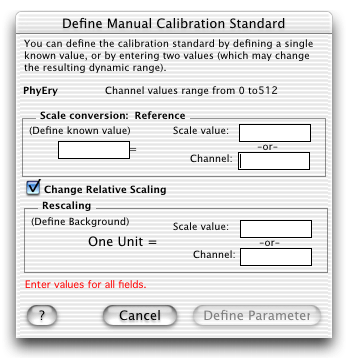Manual Calibration
If you choose the manual calibration method for calibrating a parameter, you will be shown the following window (with the exception that the "Change Relative Scaling" checkbox is not selected, and the second calibration point entry box is grayed out).

For a simple calibration, you can just enter one pair of values in the "Reference" box. Enter a known absolute fluorescence in the leftmost box, and then enter the corresponding channel number OR the corresponding scale value (of the original parameter) in the boxes on the right. If this is all you enter, then FlowJo simply rescales the original parameter by an appropriate multiplier so that the reference position is correct.
The scale value (or channel value) that you enter might be derived from a gating or calculation on the parameter from this or another sample that you have performed manually. For example, you may have stained cells with anti-CD4, and determined that the mean fluorescence of the CD4 positive cells is 25.6 scale units. You would then enter 25.6 in the "Scale Value" box, and 50,000 in the known value box (there are 50,000 molecules of CD4 per CD4 T cell), and then click on "Define Parameter". FlowJo creates a new parameter which is absolute molecules based on the conversion you entered.
Note that the one-point standard curve is the same as fitting a straight line through the origin (on a linear scale parameter), or maintaining the same dynamic range as the original parameter (for a log scale parameter). In the latter case, this means that the number of decades for the scaled parameter is identical to the number of decades for the original collected parameter.
If you wish to perform a 2-point standard curve, you can check the box "Change Relative Scaling". For linear parameters, you will then enter the scale value (or channel number) corresponding to Zero absolute units. For log parameters, in which there can be no zero, you will enter the scale value (or channel number) corresponding to 1 absolute unit. The net effect of this is a complete rescaling of the parameter. For linear parameters, this may "move" the events left or right on the graph, because zero absolute units will always be the left-most value on the graph.
For log parameters, rescaling means that you may change the number of decades in the parameter (in order to fit both known points). This means that the absolute values may no long scale with fluorescence intensity, assuming that the original parameter was a reasonable estimate of that intensity.
The effect of 2-point calibrations is too complex for the scope of this help documentation. If you need more help understanding 2 point calibrations, please contact the FlowJo administrators for more information.
